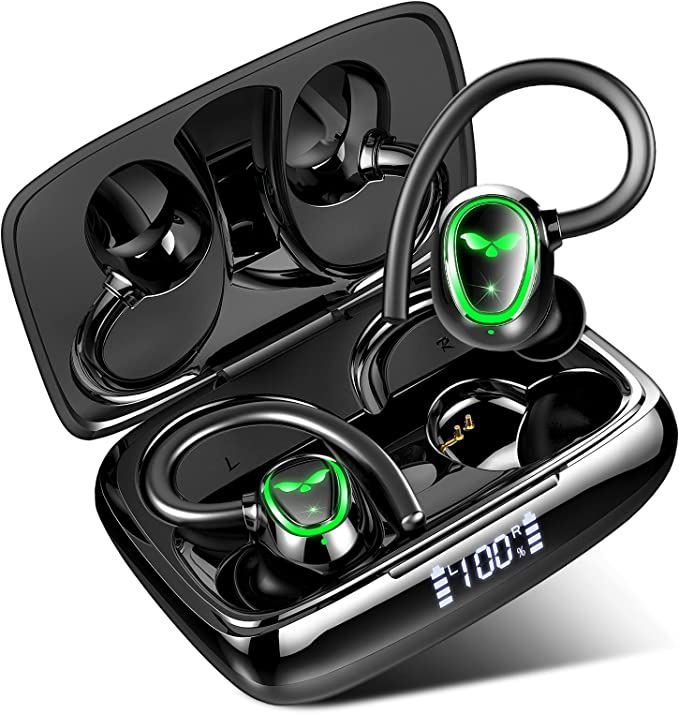The Ghosts in the Machine: How a $16 Earbud Contains a Century of Tech History
Update on July 2, 2025, 1:29 p.m.
It starts with a sickening little crunch. In the user reviews for the Wisezone 750 Wireless Earbuds, one customer, “Creampie,” matter-of-factly recounts the fate of their last pair: “After accidentally stepping on my earbud… I searched Amazon for a replacement. Something cheap because they break so easily.”
The sentiment is instantly recognizable. The feeling isn’t tragedy; it’s a flash of annoyance, a resigned sigh, and a few clicks to order a new pair for $15.99. But pause for a moment on that sound—the crack of plastic and delicate electronics. How did we arrive at a place where technology this complex, this magical, has become so utterly disposable? Is its value truly measured by the price of a couple of fancy coffees?
Perhaps we’re asking the wrong question. The value of a device like the Wisezone 750 isn’t in its novelty, but in its history. These small, glossy white pods are haunted houses, home to the miniaturized ghosts of giant, world-changing inventions. To understand them is to take a tour of the 20th century, and to do that, we need only to listen.

The Ghost of the Concert Hall: The Speaker in Your Ear
When a user praises the Wisezone 750’s “great sound quality,” they are hearing the echo of a revolution that began a century ago. Tucked inside each 4-gram earbud is a 13mm dynamic driver. To understand what that is, we must travel back to the 1920s, to the hallowed halls of Bell Labs. There, engineers Chester W. Rice and Edward W. Kellogg unveiled the world’s first true dynamic loudspeaker. It was a massive, cumbersome apparatus, designed to fill a room with sound.
Its working principle, however, was beautifully simple. An electrical signal flows through a voice coil attached to a diaphragm, creating a magnetic field that pushes and pulls the diaphragm like a piston, creating waves of pressure in the air. This is sound. Now, look at the earbud. The ghost of that room-sized invention is living inside. The same physics, the same elegant dance of electromagnetism and air pressure, has been miniaturized to an almost unimaginable degree. The “deep bass” the product page boasts about is a direct descendant of that original quest to faithfully reproduce the rumble of an orchestra, now powered by a driver no bigger than a fingernail.

The Ghost of the Viking King: The Unseen Cord
You take the earbuds out of their case. There’s no switch to flip, no button to hold down. They just work, instantly tethering themselves to your phone through the invisible leash of Bluetooth. The product information is slightly confused, listing both Bluetooth 5.2 and the newer Bluetooth 5.3. In truth, the difference for a listener is negligible. The real story is far grander.
For that, we need a 10th-century Danish king. Harald “Bluetooth” Gormsson was famous for one thing: uniting the warring tribes of Denmark and Norway. A millennium later, in 1996, engineers at Ericsson, Intel, and Nokia sought a code name for a new wireless standard, one designed to unite the disparate worlds of computers, phones, and accessories. A history-buff engineer suggested “Bluetooth.” The name stuck.
The core mission of Bluetooth was never about blasting high-fidelity audio; it was about low-power, short-range, and robust communication. This DNA, this royal legacy of unification and efficiency, is precisely why your earbuds can sip power from their tiny batteries for up to 8 hours. The version number is just a footnote in a long, ongoing story of refinement. The ghost of King Harald’s unifying ambition is what frees you from the tyranny of wires.

The Ghost of the Nobel Prize: The Pocket Powerhouse
A user review for the Wisezone 750 expresses a common form of modern wonder: the battery is “phenomenal.” The earbuds last for days, and the charging case, with its reassuringly bright LED display, can sit for weeks before needing to be plugged in via its modern Type-C port. This pocket-sized endurance is powered by a ghost that won a Nobel Prize.
Throughout the 1970s and 80s, scientists like M. Stanley Whittingham, John B. Goodenough, and Akira Yoshino conducted the foundational research that created the lithium-ion battery. They discovered a way to create a rechargeable battery that was both light and incredibly energy-dense. It was a revolution in chemistry that unlocked the portable electronics revolution. The ghost of their lab work, of their painstaking experiments, now resides in the charging case. It’s not just a plastic box; it’s a miniature chemical dam, storing a reservoir of power that turns a $16 accessory into a self-sufficient ecosystem.

The Ghost of the Factory Floor: The Armor of Everyday Life
The product description highlights its IPX7 waterproof rating. This isn’t a flashy feature, but a quiet promise of resilience. It means a user can get caught in the rain on a run or sweat through a workout without a second thought. This peace of mind comes from an unlikely place: the gritty, demanding world of industrial manufacturing.

The Ingress Protection (IP) code was developed by the International Electrotechnical Commission (IEC) to give engineers a clear, universal standard for how well an electrical enclosure could resist dust and water. It was designed for factory equipment, for outdoor junction boxes, for things that had to survive harsh conditions. IPX7 specifically means the device can be submerged in 1 meter of water for 30 minutes without failing.
The ghost of this industrial, safety-first standard has migrated into the most personal of our devices. It is a silent, invisible shield, protecting our small technological wonders from the mundane chaos of our daily lives—a spilled drink, a sudden downpour, a moment of carelessness.

The Value of a Ghost
Let’s go back to that small, crunching sound. What was lost in that moment was not just a $15.99 gadget. It was the echo of a 1920s concert hall, the legacy of a Viking king, the culmination of a Nobel Prize-winning discovery, and the resilience of a factory floor.
The true marvel of the Wisezone 750, and thousands of devices like it, is not that they are new, but that they are archives. They are proof that the most profound technological progress isn’t always the next expensive breakthrough, but the moment when yesterday’s breakthroughs become so refined, so affordable, so normal, that they are taken for granted.
Its greatest feature is its price tag. Because that price means the ghosts of a century of innovation are no longer confined to labs and corporate boardrooms. They are available to almost everyone. The next time you hold a piece of cheap, brilliant technology in your hand, perhaps you’ll see more than just a disposable gadget. You’ll see a museum you can fit in your pocket.



























































